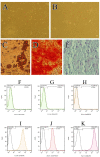Restoring the Angiogenic Capacity of the Human Diabetic Adipose-derived mesenchymal stem cells Primed with Deferoxamine as a Hypoxia Mimetic Agent: Role of HIF-1α
- PMID: 37342375
- PMCID: PMC10278222
- DOI: 10.34172/apb.2023.021
Restoring the Angiogenic Capacity of the Human Diabetic Adipose-derived mesenchymal stem cells Primed with Deferoxamine as a Hypoxia Mimetic Agent: Role of HIF-1α
Abstract
Purpose: Insufficient angiogenesis is associated with serious diabetic complications. Recently, adipose-derived mesenchymal stem cells (ADScs) are known to be a promising tool causing therapeutic neovascularization. However, the overall therapeutic efficacy of these cells is impaired by diabetes. This study aims to investigate whether in vitro pharmacological priming with deferoxamine, a hypoxia mimetic agent, could restore the angiogenic potential of diabetic human ADSCs. Methods: Diabetic human ADSCs were treated with deferoxamine and compared to normal and nontreated diabetic ADSCs for the expression of hypoxia inducible factor 1-alpha (HIF-1α), vascular endothelial growth factor (VEGF), fibroblast growth factor-2 (FGF-2) and stromal cell-derived factor-1α (SDF-1α), at mRNA and protein levels, using qRT-PCR, western blotting and ELISA assay. Activities of matrix metalloproteinases (MMPs)-2 and -9 were measured using a gelatin zymography assay. Angiogenic potentials of conditioned media derived from normal, Deferoxamine treated, and non-treated ADSCs were determined by in vitro scratch assay and also three-dimensional tube formation assay. Results: It is demonstrated that deferoxamine (150 and 300 μM) stabilized HIF-1α in primed diabetic ADSCs. At the concentrations used, deferoxamine did not show any cytotoxic effects. In deferoxamine treated ADSCs, expression of VEGF, SDF-1α, FGF-2 and the activity of MMP-2 and MMP-9 were significantly increased compared to nontreated ADSCs. Moreover, deferoxamine increased the paracrine effects of diabetic ADSCs in promoting endothelial cell migration and tube formation. Conclusion: Deferoxamine might be an effective drug for pharmacological priming of diabetic ADSCs to enhance the expression of proangiogenic factors noted via HIF-1α accumulation. In addition, impaired angiogenic potential of conditioned medium derived from diabetic ADSCs was restored by deferoxamine.
Keywords: Adipose-derived mesenchymal stem cells; Angiogenesis; Deferoxamine; Type 2 diabetes.
©2023 The Authors.
Conflict of interest statement
Hereby, it is declared that we do not have any conflict of interests on the publication of the paper.
Figures
References
-
- Karina Karina, Rosliana I, Sobariah S, Rosadi I, Afini I, Widyastuti T, et al. Diabetes mellitus type 2 reduces the viability, proliferation, and angiogenic marker of adipose-derived stem cells cultured in low-glucose anti-oxidant-serum supplemented medium. Biomed Res Ther. 2019;6(3):3073–82. doi: 10.15419/bmrat.v6i3.530. - DOI
LinkOut - more resources
Full Text Sources
Miscellaneous






